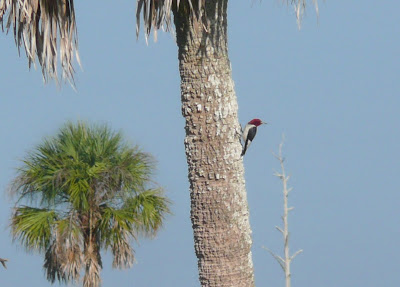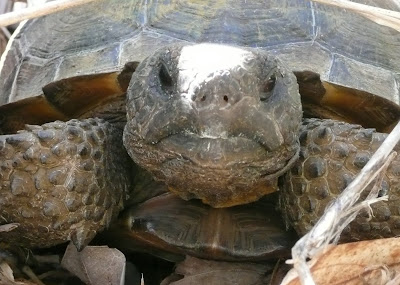Birding the Florida Keys
Memorial Day - May 31st
With the winter seasonal birds having headed north and having reached the end of the migration season, birding in southwest Florida really slows down. But, there are still have birds to find. Two very localized birds we usually only find in the Florida Keys are Roseate Terns and Antillean Nighthawks.
The roseate terns, is uncommon and are a very pelagic bird. Usually can best be found as they nest in late spring and early summer. A location often mentioned as an accessible nesting site is on the roof of the Marathon Government Center building in Marathon Key. Dozens of roseate and least terns nest on the rooftop and can be observed as they flew about.
The Antillean Nighthawk is a close relative to the common nighthawk, are mostly native to the Bahamas. They are very similar in appearance, but they can be separated by their vocalizations. The Antillean nighthawk is uncommon here, but can be found in the Florida Keys. The most mentioned location for finding any is to be at the Marathon Airport at dusk and listen for their vocalizations.
So for Memorial Day I elected to drive round trip from Ft Myers to the Keys for these Florida specialities that I have yet to add to my life list. But I also have a trio of nemesis birds, all Florida specialities, that are targets for this day as well. The Red-Whiskered Bulbul and Spot-Breasted Oriole in Kendell and the Smooth-Billed Ani in the Everglades. I have dipped on these three many, many times. Maybe today.
Took off from Ft Myers about 5:30 am to head across the peninsula along the Tamiami Trail (US41), to Krone Street and then south to US1, scheduling stops in Kendell, The Everglades National Park, Key Largo, and Marathon Key.
Stopped at
Ten Thousand Islands National Wildlife Refuge, just east of Collier-Seminole State Park in Collier County at about 7am. Just a quick stop to check out the new facilities here. The stop was quick mostly because the deer flies were terrible. Did find a calling limpkin, moorhens, and a king rail that I only heard. I would have waited for it to come out in the open but the flies eliminated that option.
MITRED PARAKEET
Got to the
Kendell Baptist Hospital campus around 8:30am and spent about a half hour scouting the neighborhood north of the hospital in search of the bulbul and the oriole. Both of these birds are ABA countable exotics that have become established in the Miami-Dade area, centering on Kendell. Even with very recent reports, noting the exact blocks to check out, I came up empty. Monk Parakeets were easily located though. Crossed back over to the hospital campus were a noisy, active flock of Mitred Parakeets were in the parking area.
 MITRED PARAKEETS AT PLAY
MITRED PARAKEETS AT PLAY
LOGGERHEAD SHRIKE
Had a good look at Loggerhead Shrike, and Muscovy Ducks were everywhere. As I was about to leave, a bit disappointed with only finding a single species of parrot here, I noticed my first Gray Kingbird of the season. It was sitting on a wire, occasionally hopping off to chase a bug and then back to its post. As I was trying to get close enough for a photo, saw a trio of swallows actively flying about. Seems to me that they were Cave Swallows, probably from the nearby colony at Cutler Ridge. The cave swallows were a nice surprise.
A Juvenile Green Heron
Next stop was at
Everglades National Park and the Anhinga Trail located at Royal Hammock. Was looking for the smooth-billed ani and spent an hour in the search. The ani was not present during my stay. Had lots of nesting Anhingas, but all of the black vultures are now gone. The most numerous wading bird were Green Herons.
Common Myna
Before reaching the Everglades National Park I was able to spot a couple of White-Winged Doves and a trio of juvenile Purple Martins in the
Florida City area. Later while stopping in
Homestead had a few Common Mynas.
 Nature Trail at Dagny Johnson
Nature Trail at Dagny Johnson
By 2pm had made it to Key Largo. So far the holiday traffic is fine while heading south. North bound traffic is another story. Stopped at Key Largo at the Dagny Johnson State Park, which is home to Florida's largest remaining stand of West Indian hardwood forest. Target birds here include the mangrove cuckoo, black-whiskered vireo, white-crowned pigeons and more gray kingbirds. Last time I was here, we had lots of mosquitoes. But today was hot but free from the pests. The woods carried the calls from Northern Cardinals and Black-Whiskered Vireos, and were the only birds seen today.
Heading south from the state park, the north bound traffic was extremely heavy and slow, saw a few of my first White-Crowned Pigeons of the day and several more Gray Kingbirds. Magnificent Frigatebirds could be seen too. Also commonly seen were Eurasian Collared Doves and Mourning Doves. Even saw a couple of common mynas in flight.

Reached mile-marker 48 about 3pm, which is also on Marathon Key and the location for seeing the
Roseate Terns. Here on the roof of the
Marathon Government Center are the nesting Roseate and Least Terns. They could be seen flying about many bringing food back to the nest. Was able to see several of each bird from the parking lot and on pilings on the water behind the building.
 The Roseate Terns can be seen here, but too far for my camera to get a better shot.
The Roseate Terns can be seen here, but too far for my camera to get a better shot.Because it was too early for siting the Antillean Nighthawk at the Marathon Airport, I elected to extend the trip to Key West with a stop at Key Deer National Refuge. Saw three of the miniature deer as they cross the road in front of me. They are only found here and are federally protected species. The buck (his growing antlers in velvet) was larger than the pair of does seen here.
Key West was very congested and I was too hot and tired to do much exploring. Took a short break and started heading back to Marathon. Missed on seeing any of the Key West chickens, but did find more White-Crowned Pigeons, Laughing Gulls, Brown Pelicans and Magnificent Frigatebirds.
It was fifty-miles back to the Marathon Airport and even with stopping to eat I was still early. Gave a jump to a fella with a dead battery at the airport location while waiting there for sun down and the nighthawks. This guy informed me that an owl came out every night to sit atop the electric pole just a few feet away. Which was intriguing. But by now I was also anxious to head for home. A long four drive was ahead of me. I felt so lucky when the Antillean Nighthawk made its appearance at 7:30pm. A good half-hour to fourty-five minutes yet till dark. First because I nailed another LIFER and because I don't have to wait anymore. I didn't wait for the appearance of the owl. I took off for home.
The trip home amplified the negative aspects of day tripping the Keys on a holiday. That north-bound road congestion had not abated. It took some three hours just to travel the 70 miles back to Homestead and I did not get home till about 1:30 am. Was it worth it? I got a couple of lifers, but I would prefer in the future to travel with patrner, rent a car ( the trip was 600 miles), get a room and use two days. And mostly avoid the holidays.
Memorial Day List - (44) Muscovy Duck, Brown Pelican, Double-Crested Cormorant, Anhinga, Magnificent Frigatebird, Great Blue Heron, Tricolored Heron, Cattle Egret, Green Egret, Turkey Vulture, Osprey, Red-shouldered Hawk, King Rail, Common Moorhen, Limpkin, Killdeer, Laughing Gull, Least Tern, ROSEATE TERN, Royal Tern, Rock Pigeon, White-Crowned Pigeon, Eurasian Collared-Dove, White-Winged Dove, Mourning Dove, Monk Parakeet, Mitred Parakeet, ANTILLEAN NIGHTHAWK, Red-Bellied Woodpecker, Gray Kingbird, Loggerhead Shrike, Black-Whiskered Vireo, American Crow, Fish Crow, Blue Jay, Purple Martin, Cave Swallow, Northern Mockingbird, European Starling, Red-Winged Blackbird, Common Grackle, Boat-Tailed Grackle, House Sparrow, Common Myna






.JPG)































